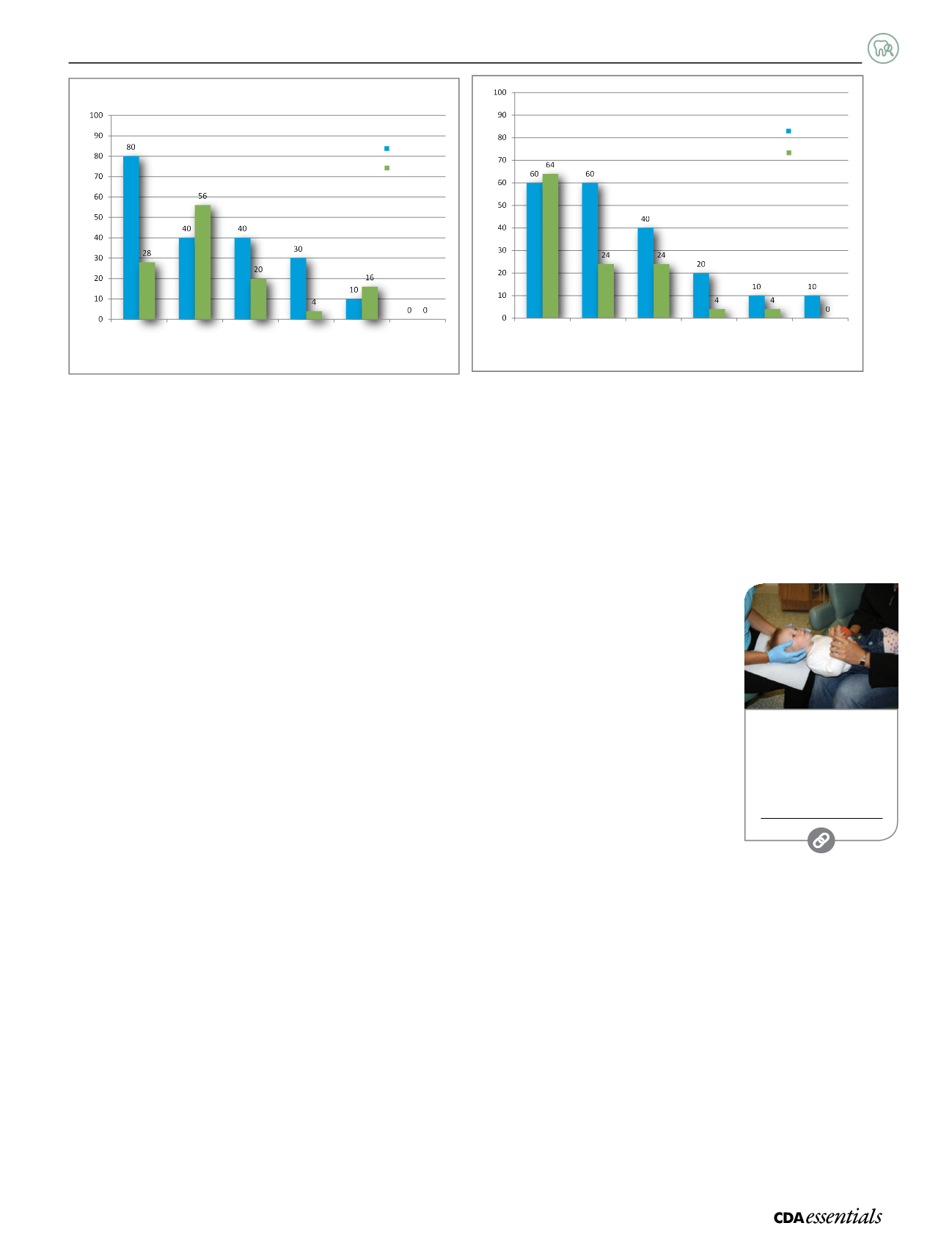
33
Volume3 Issue5
|
S
upporting
Y
our
P
ractice
andconfidence inperforming these services for young
children.
30
Inother areasof healthcareeducation,multiple
exposures toprocedureshavebeen linkedwith increased
student confidence.
31
Lackof patientswasmentionedas 1of the top2barriers to
teachingandprovidingclinical experience inprenatal and
infant and toddler oral health (
Figs. 1
and
2
). Interprofessional
educational opportunities inprimarycare settingswith
pediatrics, obstetrics and familymedicinecomponentsmay
expose students to thesepopulations. Not onlycould this
enhance training, but itmayalso foster oral healthawareness
amongnon-dental professionals and lead tobetter
coordinationof careandestablishingandmaintainingdental
homes.
Systems-Based Issues
Toensure that comprehensiveeducation inprenatal and
earlychildhoodoral health ispart of dental programs,
CDAC’s accreditation requirements shouldbe reviewed
andamended to includepregnantwomenand infants and
toddlers. Another useful approachmaybe to supplement
eachprogram’s curriculumwithan innovativeonline
moduleon infant and toddler oral health. Theevolution
of dental educationbeyond the traditional surgical toa
morepreventiveapproachand the increasedemphasison
themedical rather than the surgicalmanagement of caries
should lead tomoreuniversal adoptionof early intervention.
Considerationof developingpediatricdentistry rotation
opportunities for senior students interested ingeneral
dentistrymayassistwithworkforce issues, as such “super”
general dentistswill provide thegreatest safetynet for
pregnantwomenandchildren.
24,30,32
National oral healthcampaigns canhelpaddress the
perception, as identified inour study, that parents lack
awarenessof theneed for earlydental care. This finding is
consistentwithpediatricdentists citingparents’ diminished
valueon infant oral healthas themainbarrier for not caring
for youngchildren.
33
Apubliccampaignof CDA, CDHAor
provincial dental organizationspromoting thefirst dental
visit couldhelpchangeperceptions andhavean impact
onall aspectsof clinical practice. In
2009, the
Journal of theCanadianDental
Association
publishedanarticlealong
withacomplementaryPowerPoint
presentation to teachdentistshow to
performafirst visit for a toddler.
34
In the
context of socialmedia, platforms such
as Twitter andYouTubemay facilitate
awarenessof thesepracticeguidelines.
Althoughprofit shouldnot shape
clinical decisions, appropriate
reimbursementmayconvince some
dentists andhygienistsof theusefulness
of earlydental care, as theabsenceof
reimbursement is a knownbarrier to
caring for youngchildren.
11
A specificcode for first dental
examinations exists inCanada (code00010), but providers
maybeunawareof this and it isuncertainwhether insurance
plans accept this code. AdvocacybyCDAandCDHA to
promoteproper reimbursementmay increase itsuse.
Conclusions
Many, but not all, dentistryanddental hygieneprograms are
teaching their students about the recommendedage for
afirst dental visit. Better adherence tonational guidelines
will requireprograms toaddress current barriers impeding
learningabout this important topicand toprovidecreative
opportunities for students regardingprenatal and infant and
toddler oral health.
a
Figure1:
Barriers to teachingorprovidingclinicalexperience in infant
and toddleroralhealth indentistry (
n
=10)anddentalhygiene (
n
=25)
programs.
Figure2:
Barriers to teachingorprovidingclinicalexperience inprenataloral
health indentistry (
n
=10)anddentalhygiene (
n
=25)programs.
Lackof time Lackofpatients Program
resourcesand
nances
Teaching sta
Patient/
caregiver
perception
of need
Family nances
Dentistry
Programs (%)
DentalHygiene
Lackofpatients Lackof time Program
resourcesand
nances
Teaching sta
Patient/
caregiver
perception
of need
Family nances
Dentistry
Programs (%)
DentalHygiene
CDAhas launched
awebsite tohelp
promote the
importanceof the
first dental visit:


